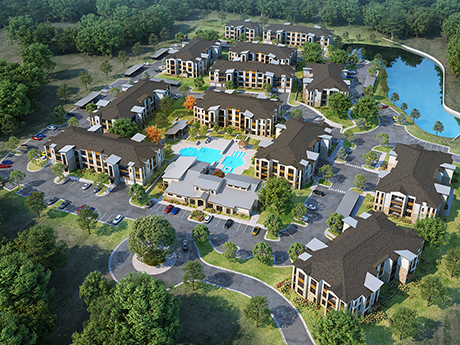By John D. Hutchinson, vice chairman, global head of origination, Trez Capital
The COVID-19 pandemic brought mass migration to the Sun Belt states, and by far, the most sought-after location of the pandemic migration boom was Texas. Multifamily investment demand remains strong due a higher quality of living, affordability and job growth. People are leaving high-tax, high-regulation states and moving to states like Texas with lower taxes and more favorable business climates.
Austin, specifically, has outshone the top cities in the “Texas Triangle” with its large influx of both people and jobs. Austin’s exponential population growth, attractive cultural qualities and high-income jobs have created demand for and premium prices on real estate.

John Hutchinson, Trez Capital
Although the U.S. economy has seen changes in the last couple of months, such as inflation and interest rate hikes, the city still affords a great opportunity for multifamily investors. According to data from CoStar Group, Austin has doubled its construction starts over the past year and is expected to add 15,827 new units in 2022. In fact, there was a record 25 percent rent growth and strong occupancy at the end of 2021.
A Growing Market
In 2021, the Austin area’s net population growth was about 16 new residents moved per day, according to data from the U.S. Census Bureau. Austin is the fastest-growing city in Texas and the fastest-growing city in the nation over the last 10 years, with its population climbing 35 percent over the last decade. Houston and Dallas have also seen significant population increases, but Austin has outpaced both.
A big reason for the city’s growth is the job market, which is one of the hottest in the country. The city has become a high-tech center, and many large corporations have moved their headquarters to the Austin area from Los Angeles, San Francisco and New York because of the state’s business-friendly climate.
In 2021, a business network for companies relocating, expanding and growing in the Lone Star State, called YTexas, reported that 62 corporations relocated to the Austin area. Elon Musk, who is building the Tesla Gigafactory on the outskirts of the city of Austin, also announced that Tesla would relocate its corporate headquarters to Austin from the Silicon Valley. These high-profile business moves are attracting and retaining talent, mostly due to competitive high-income opportunities.
In addition to a growing job market, Austin is a dynamic city for entertainment and those looking for an active lifestyle. Not only is it aesthetically pleasing via Lady Bird Lake, a recreational river-like reservoir, but Austin is also surrounded by expansive nature trails and hikes. The Texas Hill Country is also centrally located — a short drive to Dallas, Houston and San Antonio. Austin is the live music capital of the world and has been ranked as the No. 1 city to live by U.S. News & World Report several times over the last decade.
With so many new people drawn to Austin, demand for multifamily product continues to outpace supply with no signs of slowing down in the next two to three years. In 2025, the vacancy rate for an apartment in Austin is predicted to be between 1 and 2 percent. Future Austin residents will be able to afford heftier rents due to high-income jobs in the area. As a result, rents could rise above the cost of owning a home in Austin over the next few years.
According to real estate database company ATTOM, it is currently more affordable to rent than buy a home in Austin. The 2021 median home price was $500,000. Single-family home prices and mortgage rates have gone up, so many of the city’s residents are renting longer than previous generations, generating extra demand for build-to-rent units. Due to consumer demand, investing in Austin multifamily is — and will continue to be — a phenomenal opportunity, despite all the changes happening in the economy.
Development Trends
Location, market positioning and demand drivers such as regional job and population growth continue to fuel multifamily development.
The areas in Austin experiencing the highest growth in new construction are North Austin (Pflugerville and Round Rock) and East Austin. Generally, East Austin is less expensive because of the typography. The land is flat, making it easier to clear, and typically, there are fewer trees. Also, these areas are conveniently located next to major highways like I-35 and State Highway 130.
People want to live in aesthetically pleasing buildings with high-quality, top-tier amenities, services and flex spaces, coupled with beautiful interior finishes. For instance, pet-friendly amenities have increased in popularity. According to a study by ApartmentAdvisor, Austin topped the list of metros with the highest availability of
dog-friendly rentals at 83 percent. Now more than ever, residents are looking for communities with dog parks, dog washing stations and private fenced yards.
Trez Capital has partnered with industry-leading developers to help meet the city’s increased demand for multifamily properties. Our projects include The Dalton, a 330-unit apartment complex constructed on 21 acres; and The Larkspur, a 504-unit garden-style multifamily project that features a leasing office, amenity center and a resort-style pool. The Larkspur is located in Leander, one of North Austin’s fastest-growing suburbs.
As more investors and developers enter this competitive multifamily market, it is important to design and build communities where people want to live and that offer distinctive apartment home features and amenities that enhance residents’ lives.
Although big changes are happening in our economy and housing market, Austin is only going to get bigger. Now is the time to invest in the state capital’s multifamily market, as renter demand is surging, and there is every indication that this product type will remain in demand for the foreseeable future.
— This article originally appeared in the July 2022 issue of Texas Real Estate Business magazine.


